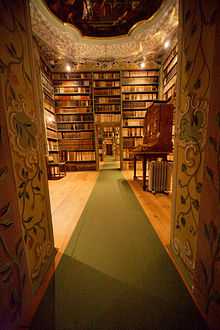St Peter's Abbey, Salzburg
St Peter's Abbey (German: Stift Sankt Peter), or St Peter's Archabbey (German: Erzabtei Sankt Peter), is a Benedictine monastery in the Austrian city of Salzburg. It is considered one of the oldest monasteries in the German-speaking area, if not in fact the oldest.
History
St Peter's Abbey was founded in 696 by Saint Rupert at the site of a Late Antique church stemming from the first Christianization in the area in the days of Severinus of Noricum. Likewise the establishment of the monastery was meant to forward the missionary work in the Eastern Alps. Until 987, the office of the abbot was joined to that of the Archbishop of Salzburg: the two were always held together by one man.
In the Middle Ages, St Peter's was known for its exceptional writing school. In 1074, Archbishop Gebhard of Salzburg sent several monks to the newly established filial monastery of Admont in the March of Styria. In the 15th century, the abbey adopted the Melk Reforms. In 1623, Archbishop Paris Graf von Lodron founded the Benedictine University of Salzburg, which until its dissolution in 1810 was closely connected to the abbey.
From 1641, the abbey was a member of the Salzburg Congregation, merged in 1930 into the present Austrian Congregation (of which it is the principal house) of the Benedictine Confederation.
In 1926, the endeavours for the establishment of a Catholic university led to the foundation of the Benedictine college ("Kolleg St. Benedikt"), on which later the re-foundation of the University of Salzburg was based. In 1927, St Peter's was raised to the status of an Archabbey.
During the Nazi period, the monks were expelled, but the monastery was not dissolved and the monks returned after the war.
Abbey church
The present-day Romanesque building at the northern foot of the Mönchsberg was dedicated in 1147. One of the organs had been built on the rood screen in 1444 by Heinrich Traxdorf of Mainz. While the steeple received its onion dome in 1756, the interior, already re-modelled several times, was refurbished in the Rococo style between 1760 and 1782 under Abbot Beda Seeauer by Franz Xaver König, Lorenz Härmbler, Johann Högler, Benedikt Zöpf and others. The high altar is a work by Martin Johann Schmidt. The St Mary's Chapel contains the grave of Abbot Johann von Staupitz (d. 1524), a friend of Martin Luther.
Mozart's Great Mass in C minor was premiered in the church, probably on 26 October 1783, with his wife Constanze singing first soprano.
Next to the altar where St. Rupert is entombed lies the tombs of Mozart's sister Maria Anna Mozart (Nannerl), and Johann Michael Haydn. Also entombed at St. Peter's Abbey is St. Vitalis.

Library, archives and other collections
Library
St Peter's houses the oldest library in Austria. Among the 800 manuscripts the most precious is the Verbrüderungsbuch, which was deposited in 784 by Bishop Virgil. Through continual acquisition, the library has grown to 100,000 volumes, focusing particularly on Benedictine monasticism, medieval church history, history of art, and items relating to the local history of Salzburg, or Salisburgensia. Special collections include incunabulae and early editions, graphics including the devotional images collection of Father Gregor Reitlechner and the map collection.
In 1768, Abbot Beda Seeauer had the medieval Zellenbibliothek converted to the Rococo style. In 1999, it was restored and is now only accessible by special permission.
Archives
The archive is for the purposes of abbey administration and the researching of its history. It contains documents from the 8th to the 20th centuries, in the following series:
- Deeds: c. 4,300 deeds up to 1700;
- Manuscripts Series A: chronicles, journals, chapter minutes, visitations, endowments, necrologies and rolls, inventories, accounts and so on;
- Manuscripts Series B: official records of estate ownership (cartularies, registers, feodaries, court records);
- Files: records and correspondence of the abbots, the monks, the chancery and other administrative offices of the abbey; files relating to estate ownership;
- Other: photographs, maps and plans.
Music archive
As a result of contact with notable musicians of Salzburg, St Peter's possesses a significant collection, much of it in holograph, with works by Johann Ernst Eberlin, Anton Cajetan Adlgasser, Leopold and Wolfgang Amadeus Mozart, Joseph Haydn, Sigismund von Neukomm, Robert Führer, and Karl Santner.
Other collections
The abbey also owns collections of paintings, church treasures, artworks, minerals, furniture, musical instruments, a coin cabinet, and a cabinet of natural curiosities (not accessible).
Institutes in St Peter's
Institute for Benedictine Studies
In order to give young German-speaking Benedictine monks and nuns the opportunity to advance their education on monastic subjects, the Salzburg Abbots' Conference of 2000 set up the Institute for Benedictine Studies to serve the study of and research into the Rule of St Benedict. The director is Dr. Michaela Puzicha OSB.
Austrian Liturgical Institute
Through the endeavours of Father Adalbero Raffelsberger, St Peter's was one of the earliest homes of liturgical revival in Austria. In 2001, the Liturgical Institute of the Conference of Austrian Bishops was attached to it.
Stiftskeller
The St. Peter Stiftskeller was first mentioned in an 803 deed issued by Alcuin of York, an English scholar attendant Emperor Charlemagne; it therefore claims to be the oldest restaurant in Central Europe.[1]
References
External links
| Wikimedia Commons has media related to Stift Sankt Peter. |
- (German) St Peter's Archabbey website
Coordinates: 47°47′49″N 13°02′45″E / 47.79694°N 13.04583°E